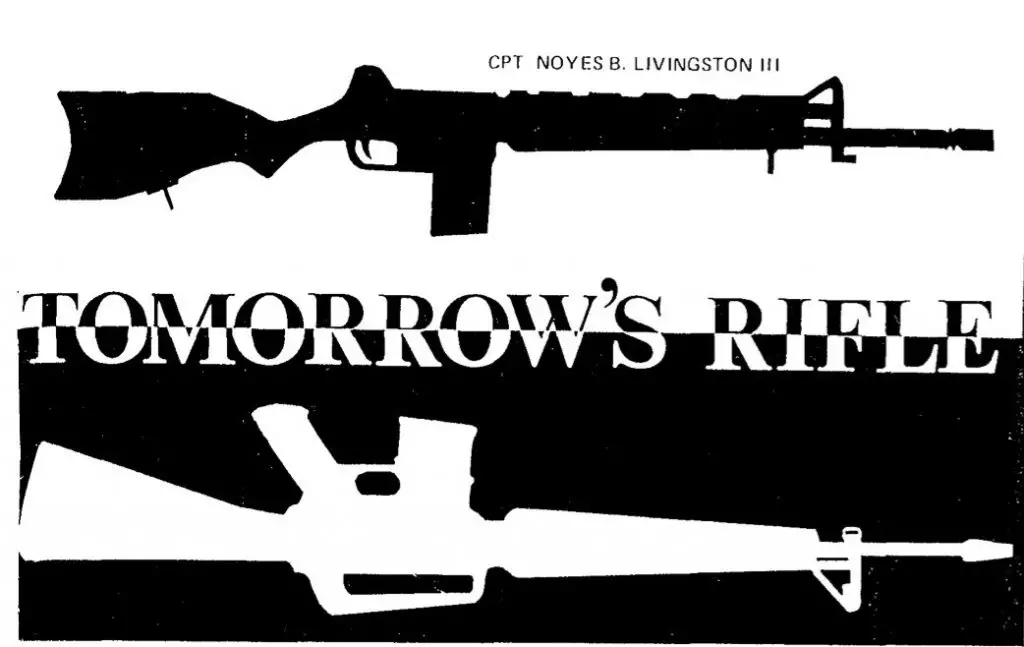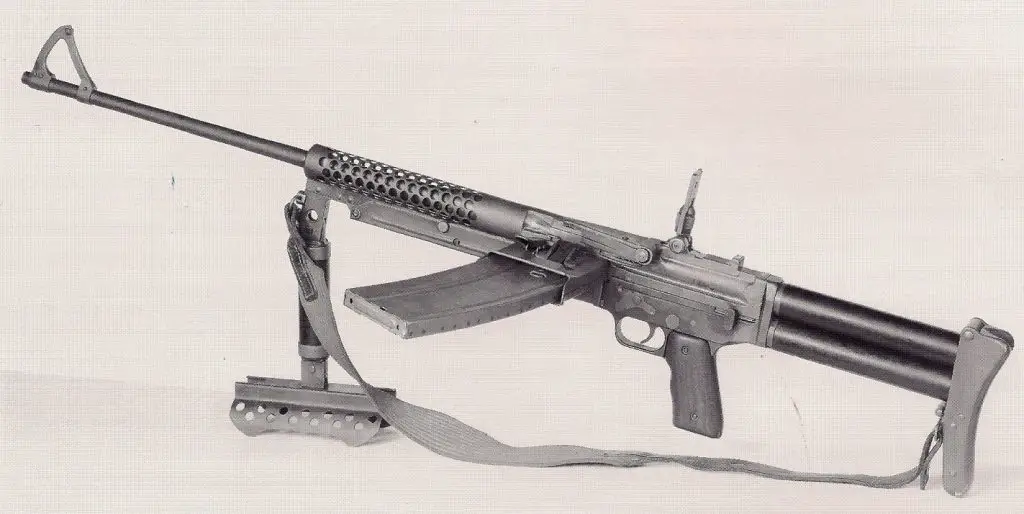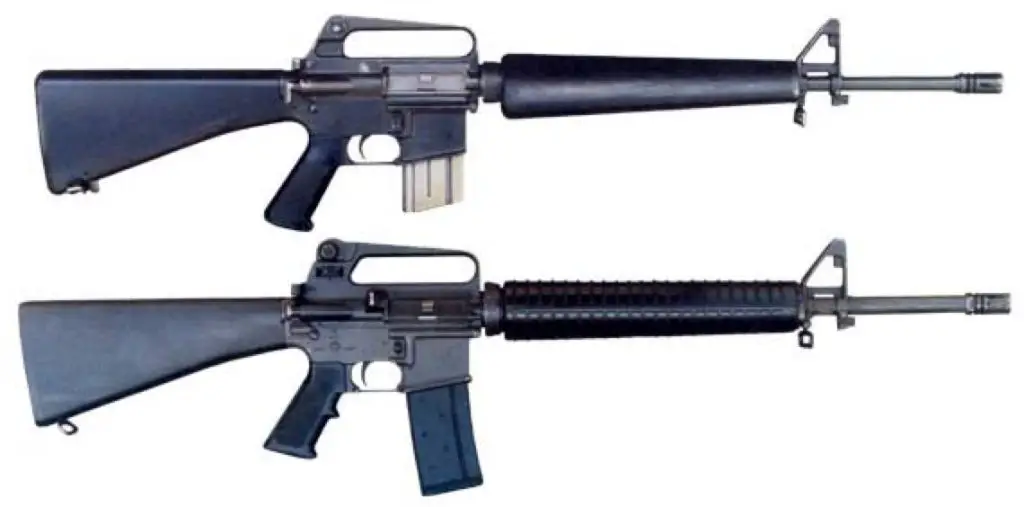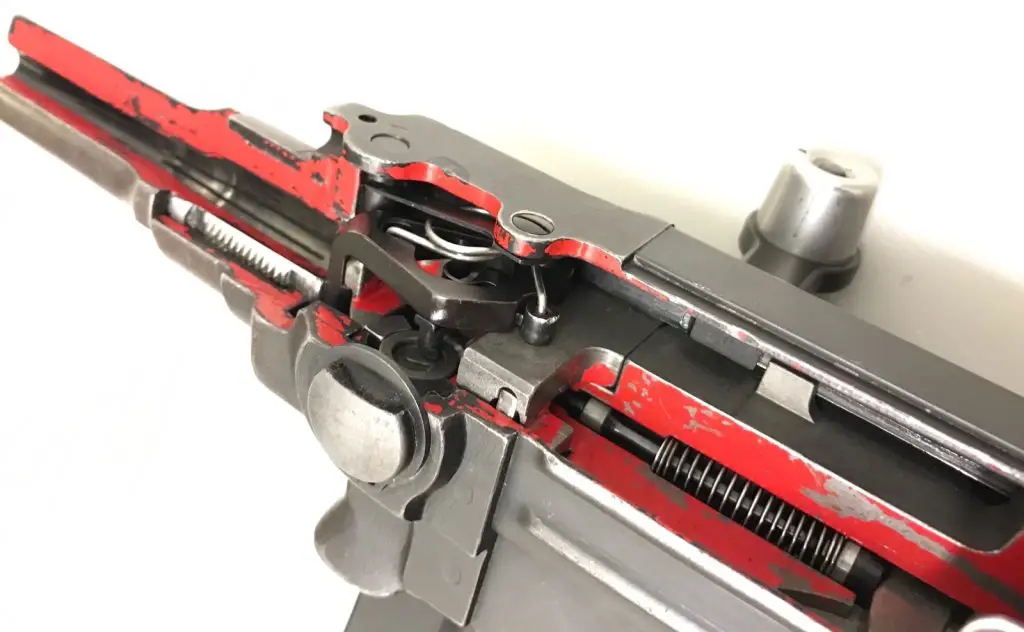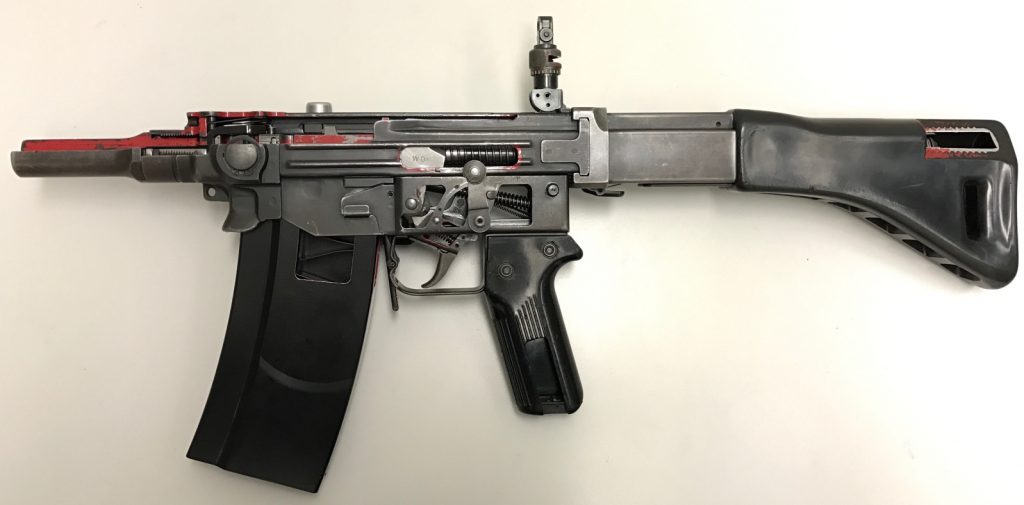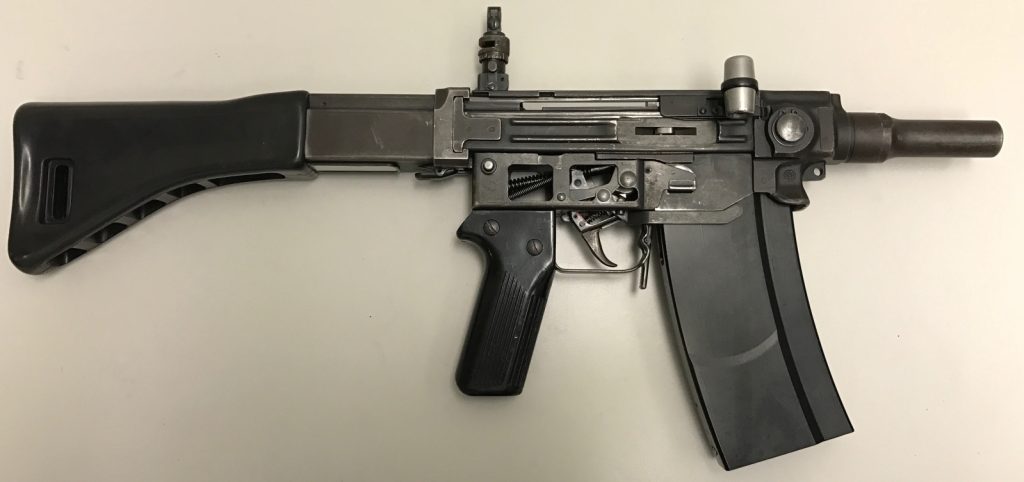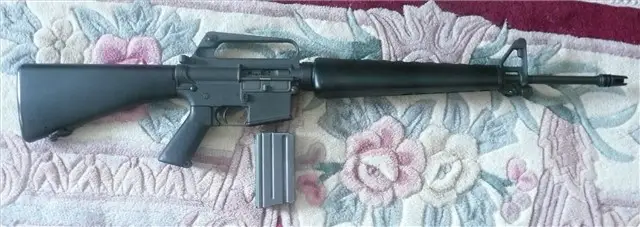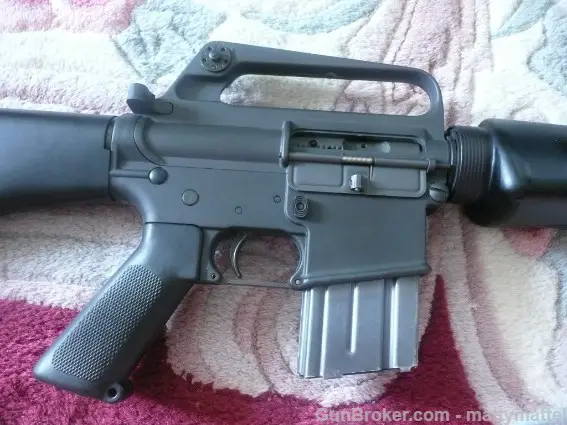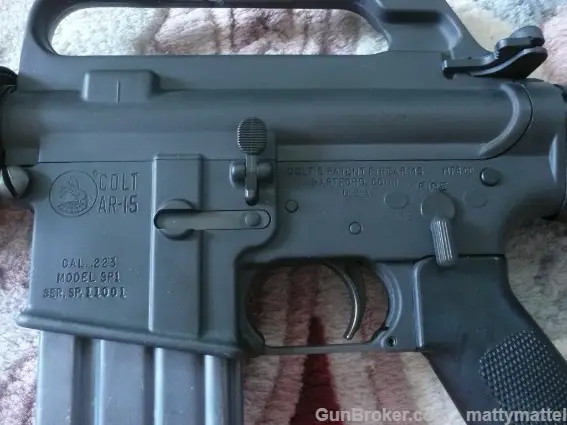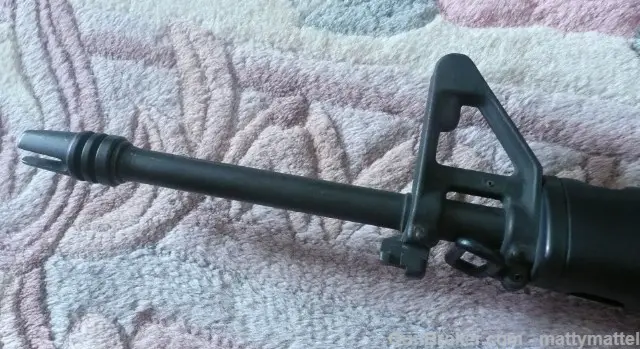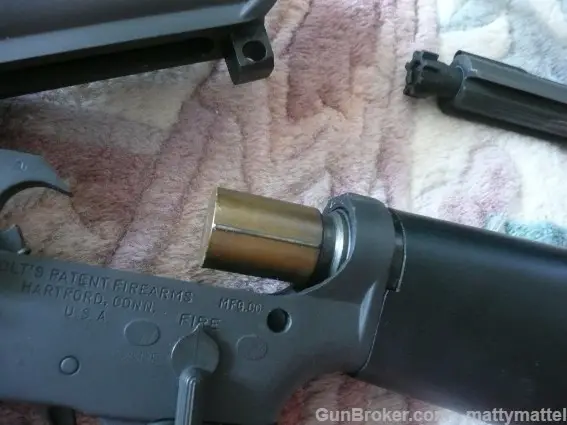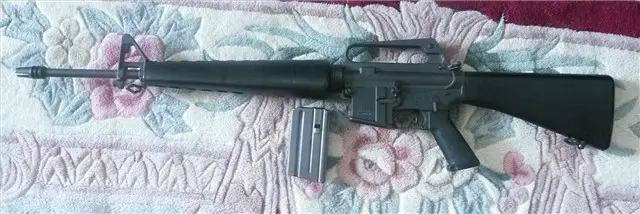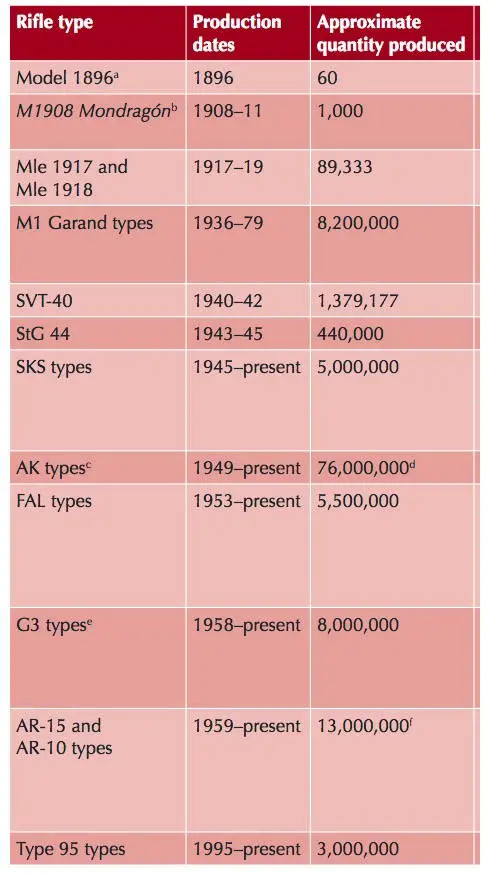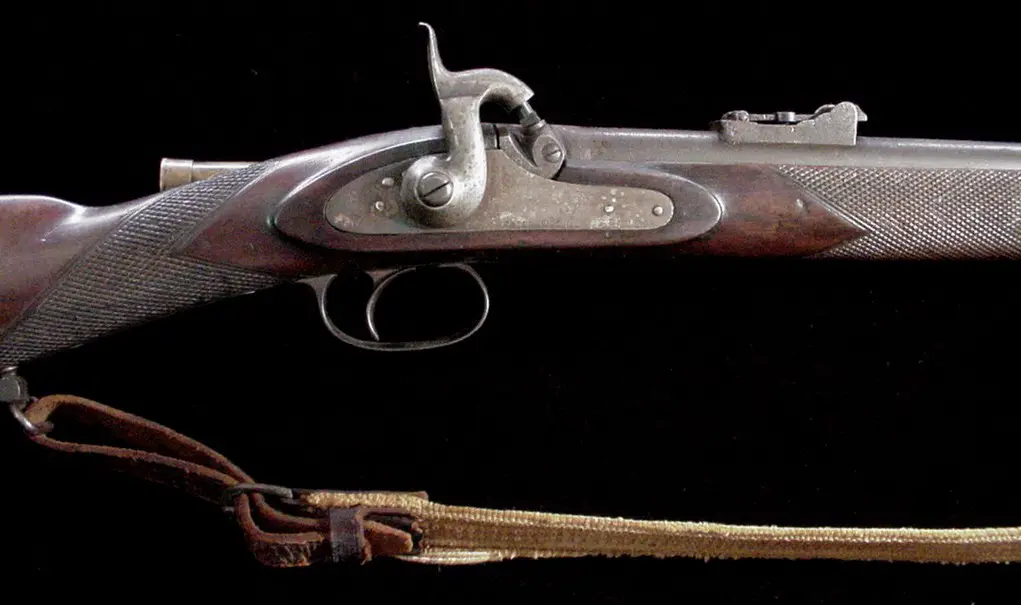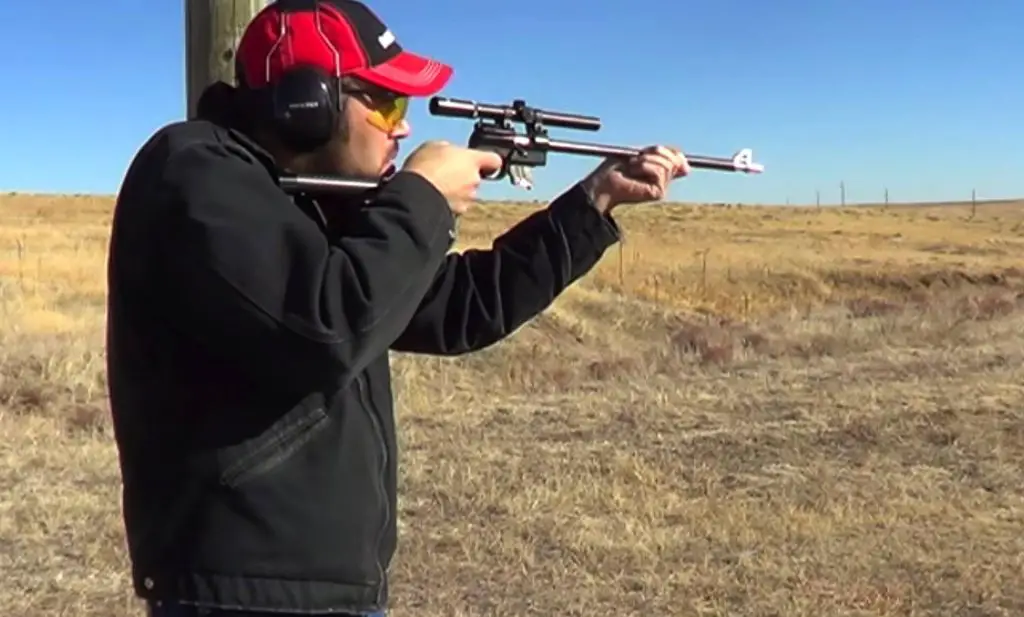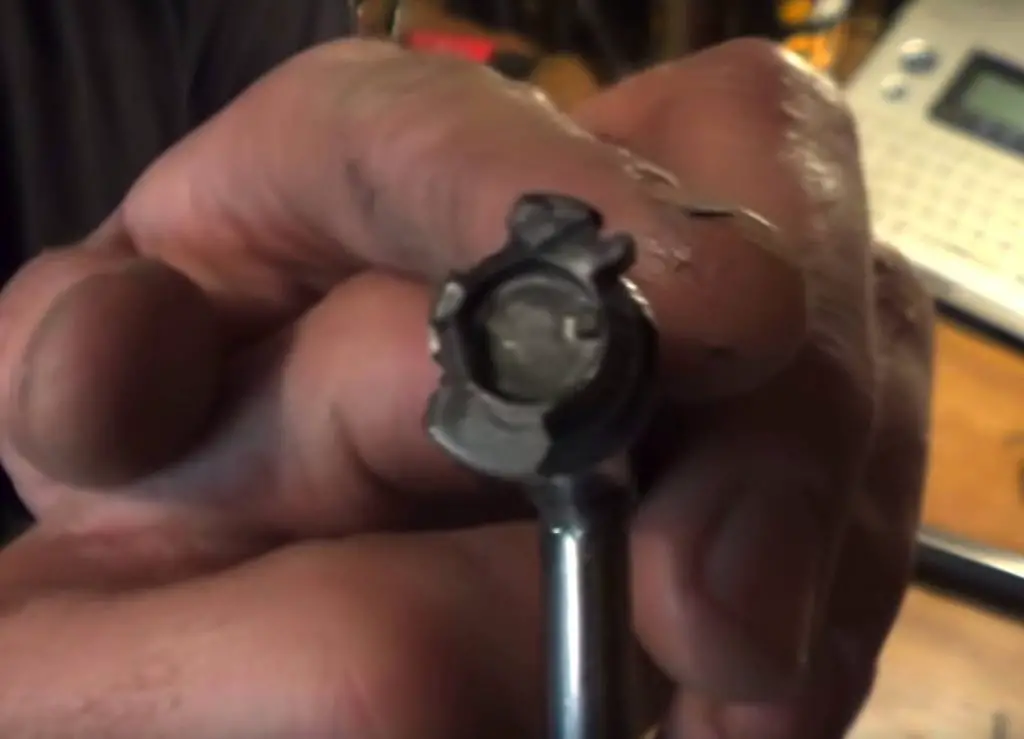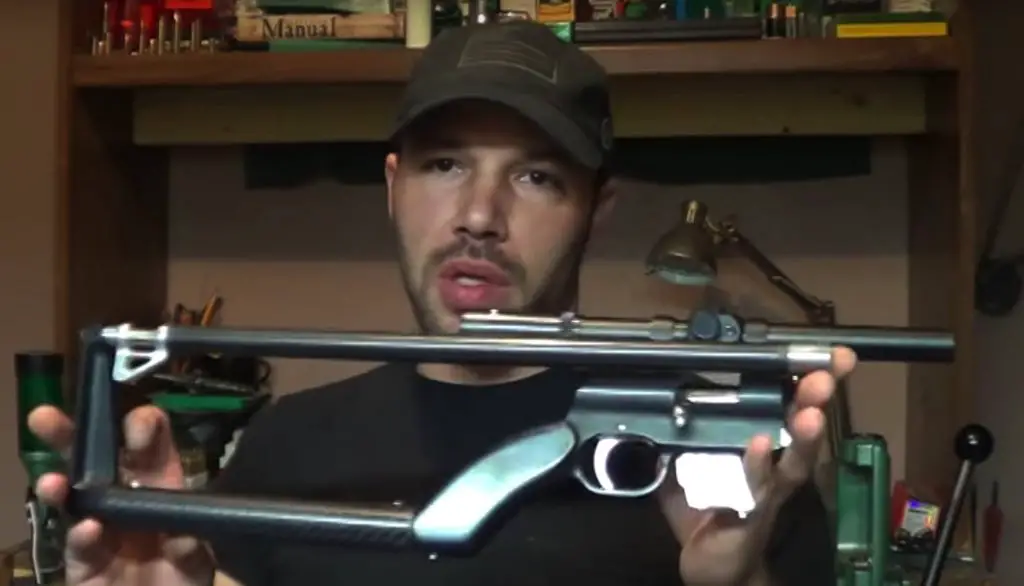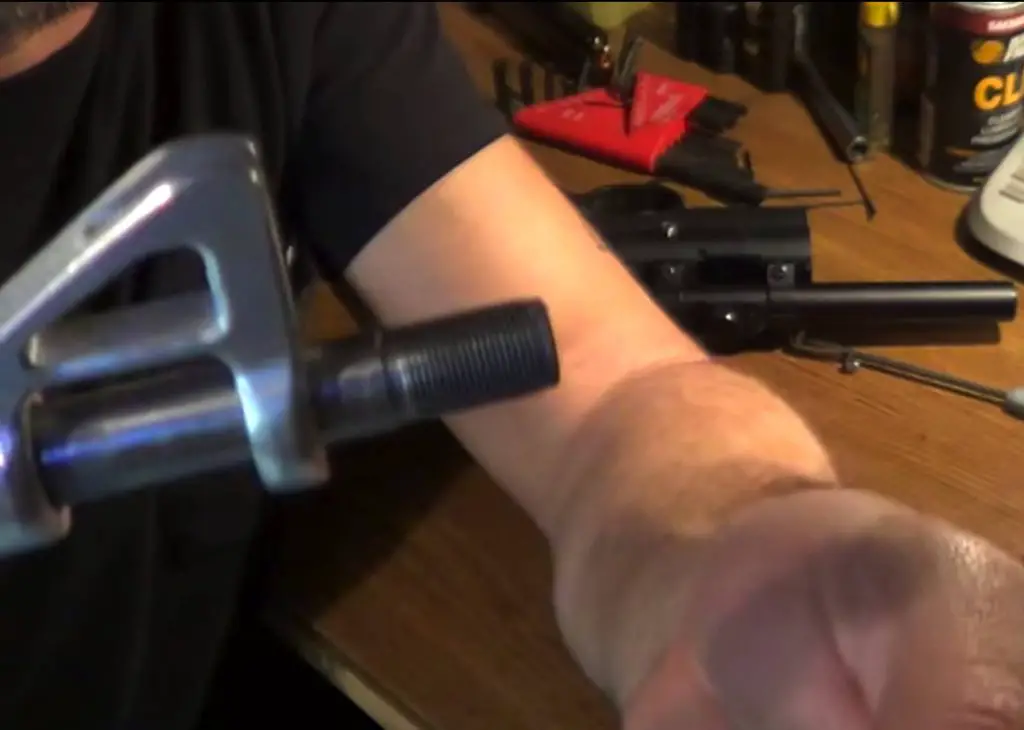There’s always a market for prediction about the future, and they’re always hostages to fate. So, today, we’ll open a time capsule from 1982 (specifically, from the November-December issue of the US Army’s branch magazine, Infantry, as seen at right) and see how whether one officer’s prediction panned out — or whether it just panned. Subject of prediction, or perhaps more honestly, subject of advocacy: a new rifle for the Army in the last quarter of the 20th Century.
The officer in question was a Texas Army National Guard officer named Noyes Burton Livingston III, about whom we know only that he’s still alive, was married at least three times (triumph of hope over repeated experience, or maybe he went SF), and is well-remembered as a writer for Iron Horse, a motorcycle magazine.
The United States infantryman has fought on many battlefields over the years, always doing his best on each with whatever rifle he happened to have at the time. And his potential battlefield continues to change and expand.
Through the use of thermal energy, ground surveillance radar, night vision devices, and intrusion warning systems, detection and engagement ranges are increasing in distance but decreasing in time. As a result, the U.S. infantryman will no doubt eventually get a new rifle to carry into battle — and he will need it.
So far, so good. Not a bad prediction for 1982. Indeed, the observation that “detection and engagement ranges are increasing in distance but decreasing in time,” for the grand European battle that the Army of 1982 was fixated upon, was a keen insight.
His present rifle, the M 16A1, is a good weapon. It is well made, lightweight, and accurate at battlefield ranges. It is handy to shoot, and it disassembles easily. In fact, it is almost everything a marksman or a service support soldier could ask for. Unfortunately, though, it is not designed to fill the basic requirements of the soldier who has to stake his life on it, the infantryman. So we need to begin thinking now about what kind of rifle we would like to have to replace it. We must not leave it to chance, as we have sometimes done in the past.
Of course, at that time the Army and Marines were both experimenting with new rifles, a project that would lead in less than a year to USMC and later Army adoption of the M16A2. But Livingston had no way to know that at the time.
No matter how much warfare changes, though, the infantryman’s war will still be brutal and intimate, and his rifle must be designed with that in mind. He must also believe in its capabilities and should be encouraged to use it. Besides shooting rapidly and accurately every time it is called on, an infantryman’s rifle must be able to double as a club, a spear, or a crutch. It may also have to help make a litter, form part of a hasty ladder, or scoop out a hurried fighting position. In short, it must function when everything else has failed.
That seems to sum up his requirements, and as you see, he’s putting a lot of weight on non-rifle functionality. Now he gets into specifics:
How should an infantry rifle be made to meet these high expectations? First of all, it cannot I;le encumbered with a carrying handle. We have all seen the classic example of a soldier running in training, one hand on his helmet and the other clutching his MI6 by the carrying handle, like a commuter with his lunch pail chasing a departing bus.. The handle makes the weapon easy to carry, but not easy to fire quickly.
A rifle must be built to fit naturally in a carry that lends itself to an attitude and position of readiness. The firing hand must grasp the small of the stock near the trigger, and the off hand must grab it slightly forward of its center of balance. A soldier should have to move only one hand to point and fire his weapon, not both.
He’s missing the main purpose of the “carrying handle,” which is not, mirabile dictu, to carry the firearm. It’s there to provide a home for the rear site that works with anthropometric dimensions and the desire to provide a straight-line stock.
Initial Armalite military rifle designs had ordinary drop-heel stocks, but then evolved into the straight-line stock, and the first model of what would become the AR-10 provided a front sight on a Johnson-inspired triangular base and a rear sight on an FG-42-like folding stalk. Here’s the 1944 Johnson for comparison.
The “carrying handle” was an attempt to make a virtue out of the necessity of making a more rigid rear sight base.
We ought to mention that at this particular point in time, the Army’s culture, and particularly Ranger and Infantry culture, was absolute death on slings. Why? Well, slings encourage the soldier to carry the rifle some way other than at the ready.
Of course, this fixation on ready carry suggests that every soldier is always and everywhere mere moments from a small arms engagement, and at that, so few mere moments that he would not have time to change his grip on his gun.
It also assumes that a soldier would be so suicidally stupid as to not carry the gun at the ready whilst in the presence of the enemy. But then, Infantry is primarily written and read by officers, who are aware that enlisted men are stupid, but sly and cunning, and bear considerable watching.
Likewise, while a pistol grip may be necessary for a light machinegun, it is a liability on a rifle. Given a rifle with a pistol grip, a soldier cannot drop to the ground into the prone position without removing one hand from his weapon to break his fall. If he does not use the pistol grip, but holds onto the stock to let the butt of the rifle strike the ground instead, he must release his hold before he can reach the grip and shoot. The same soldier cannot cease firing and jump up to rush forward without removing his firing hand completely from his weapon to grab the stock and push off with it. It is extremely difficult to hold onto a pistol grip and get up another way.
Once up and running, this soldier cannot fire his remaining rounds and then lunge effectively at his opponent with his bayonet, or follow up with a butt stroke, without completely losing hold of his rifle with his strongest hand. Although bayonet fighting may be a relatively small thing,when it is all an infantryman has left, it is everything, and close combat is no place for changing hands or coming in second best.
OK, he’s really stressing the heck out of the non-rifle applications of rifles, isn’t he? But we’d suppose he would argue that you can make a better club and halberd out of a rifle without compromising its rifle functionality. His rifle now looks like this:
Let’s get a little deeper into his conceptual design.
TECHNIQUES
A pistol grip also discourages the use of several important shooting techniques. With such a grip, a soldier’s arm follows the angle of his firing hand when he is holding onto his rifle, causing his elbow to press against the side of his body while he fires. This eliminates the shoulder pocket that the weapon’s butt is supposed to fit into to lessen the effect of recoil, steady the weapon, and keep it from slipping off his shoulder. Without a good shoulder pocket, it is hard for a soldier to maintain a firm stock weld with his cheek, to make his head move with the rifle as it recoils, and to keep his eye aligned with the sights.
A rifle should have a semi-pistol grip to improve marksmanship and to allow the soldier to hold it while running, leaping, and crawling and still have his firing hand in position to pull the trigger. It should also have a semi-straightline stock with a raised comb. The gas cylinder and operating rod should be above the barrel to reduce muzzle climb when the rifle is fired. Because the small of the stock would drop to form the semi-pistol grip, the rifle cannot have a buffer behind the receiver as the MI6 does. There are many existing weapon designs, such as the FN-FAL, the AK, the AR18, the SiG 540, and the Valmet M62, that can be modified to fit a traditional rifle stock.
In a rifle of this type, there would be no gas tube — as in the MI6 — to blow contaminants into the rifle’s action or gas and excess lubricant into the firer’s eyes. The bolt would lock fully until it was withdrawn by the operating mechanism, instead of using a delayed blowback principle, so varying qualities of ammunition could be used.
Actually, if you want to use a wide range of ammo pressures (because the pressure is what the gun “feels”, and what influences the gun), it’s hard to beat the HK roller-delayed system. Blowback and gas-unlocked systems both have narrower ranges of impulses that they can tolerate — at least, as far as they’ve been designed so far.
The barrel would be heavy enough to support a bayonet, and its bore and chamber would be chrome-plated to resist corrosion and wear.
The rifle would share many of the beneficial features of the M16 and its contemporaries. The receiver would be split into an upper and lower group held together by takedown and pivot pins. This would allow placing the rear sight at the back of the receiver, instead of at the front, by doing away with a bolt cover like the one found on the AK. This placement would permit using a rear sight aperture and a longer sight radius.
The lower receiver group would incorporate a sturdy integral magazine well and a winter trigger guard that would swing forward against the magazine when released. It would accept MI6 aluminum or nylon magazines and would have all the weapon’s controls accessible from the firing position. The selector lever would be manipulated with the firing hand thumb, and the magazine catch button would be worked by the trigger finger. The bolt catch would be released by the thumb of the loading hand after a loaded magazine was inserted.
When the firer pulled back on the charging handle to lock the bolt to the rear, the bolt catch would be engaged with the firing hand thumb.
That would actually be an ergonomic improvement on the AR-15’s generally excellent ergs, would it not?
EJECTION
The upper receiver would have a covered ejection port on its right side and a charging handle fixed to the bolt carrier on its left. There would be no bolt forward assist on the receiver as the charging handle could be pushed forward to close the bolt. Placing the charging handle on the left side would allow the action to be cycled from a firing position without the firer moving his firing hand or the weapon, as must be done with the MI4 or MI6. The charging handle would be at the left front of the receiver where it would not strike the non-firing hand. Its motion would be hidden from the firer’s view by its speed and by the rear sight’s elevation drum, which would also be on the left.
The rifle would be a little longer and slightly heavier than the MI6. It should fire at a moderate cyclic rate from the closed bolt position with the bolt remaining open after the last round was ejected. Automatic fire should be limited by a 3- or 4-round burst control mechanism. It would have a concave recoil pad to hold it in place during automatic fire, and it would accept an MI6 clothespin bipod.
Heh. We see the 1980s fad of the burst control raising its ugly head. Bad substitution for training troops. The military has finally, if not completely, killed this bad idea 35 years later. Bring more fire, lest it respawn.
The new rifle’s flash suppressor, sling swivels, bayonet, bayonet—stud, and front sight assembly would be the same as those on the MI6. Its rear sight would be similar to the one on the MI4. The fiberglass stock would be made like the MI6’s, and the easily gripped triangular handguards would be held on with a slipring in the same way. The stock should not be constructed to fold or collapse because that feature would make it less rigid. In addition to the standard 20- and 30-round MI6 magazines, a short magazine that fits flush with the bottom of the magazine well should be issued for civil disturbance and ceremonial duties.
A couple of interesting ideas there, including the need for robustness of the stock. But then again, he sees it as primarily a club with a sideline in shooting, so why not? The flush magazine, delete the useless 3-round-burst, and it would even be NY/CA legal! (They’d surely find some way to ban it).
Many excellent weapons made by friendly nations, and some by not so friendly ones, are available that we can examine and test during the process of developing our own rifle. It is important to keep in mind that our rifleman does not need the most sophisticated design possible, one such as the Austrian STG 77, the French MAS, or the Swedish MKS, but he does deserve an infantry weapon that fits the conditions under which he must fight.
He makes an interesting point. In the M16A2 tests no foreign weapon was seriously compared or tested. Indeed, no systematic survey of the field has been made before any recent American small arms procurement decision.
This proposed rifle is offered to support, not replace, the squad and platoon automatic weapons. It would first serve the rifleman with aimed semiautomatic or limited burst fire, Its adoption would result from the recognition that infantry combat is more than a “mad minute” fought by individuals. An updated yet traditional rifle would reaffirm the infantryman’s role and signal a return to the tactics of soldiers fighting together. Fire superiority would become the product of superior fire by the unit, not random fire by its members.
If we begin now to plan for the rifle of the future, perhaps when the time comes for a quick decision on a replacement for our present rifle, we will have the right one waiting in the wings.
Well, we got the M16A2 at the time, so make of that what you will.
Assault Rifle, Alpine Style, Clear as Ice Edition
Thanks to Chuck at GunLab for turning us on to this incredible post on the Swiss Rifles message board. As Chuck tells it, Dale got hold of, not a rare StG 57, but a rare2 cutaway version of the StG 57.
And then he posted a series of photos and a thoughtful analysis of this highly unusual rifle that replaced the Swiss Army’s rifles, light machine guns, and submachine guns at once. (Does that make it the Swiss Army Knife of rifles? Sorry, couldn’t resist.)
As Dale explains, there’s a lot that’s unique about the StG 57:
The Stgw 57 is an interesting battle rifle. The rationale behind this gun was to arm the infantry with an “universal weapon” that would replace the bolt-action rifle, machine gun and machine pistol. It was selected in late December 1956 over the Waffenfabrik Bern competitor for cost reasons (the SIG prototype costed only 495 CHF to produce over the 1100 CHF that the W+F Bern model required).
It was always expensive, and while a semi model sold in trickles in the USA, the high price and the rare (here) 7.5 mm caliber kept it from taking off. One of our team sergeants had one and it was a thing of rare beauty (we think he later traded it for an NFA registered 4.2″ mortar). A later export model was chambered for 7.62 mm NATO, but it didn’t sell any better.
It incorporates a modified roller-delayed blowback mechanism inspired by the StG45/Gerät 06 H prototypes, folding sights from the FG42, and a buttstock socket just like the famous MG42. In order to reduce production costs, SIG used innovative production techniques and rubber/polymer materials for the rifle’s construction, in an effort to minimise the number of machined parts.
The cutaway provides a rare chance to truly observe and understand this unusual weapon. The original post includes comprehensive photographs and explanations.
Of course, being a Swiss rifle, no compromises were made on the quality of the construction and overall robustness. Because of its heavy, welded, machined, stamped and brazed construction, the Stgw 57 weighs a whopping 6,5 kg fully loaded! Not only is the rifle one of the heaviest service weapon of the world, it is also one of the most expensive! Each Stgw 57 costs the Swiss government a grand total of 1000 CHF (of which 495 CHF are production costs and 75 CHF accessories).
In this post, we’ve placed a couple of selected images. But really, you must go there and Read The Whole Thing™; you’ll see many more images and each one has a deep technical description of what you’re seeing. Very highly recommended!
Is this a Record for a Colt AR-15 Sporter? $4,000!
A most surprising sale at GunBroker in which hot bidding led to a relatively ordinary Colt AR-15 Sporter (Serial SP1 11001) selling for a mighty high four large.
There are reasons it might have gone that high. For one thing, as pictures showed, it was in very, very good condition, and if we know one thing about collectors, “Condition, condition, condition” is as much their mantra as “Location, etc.” is to realtors. This rifle shone as if new.
It also had a memorable serial number that tracked it to 1968.
SP1s of that period still retained most early-production AR-15 features, because as rolling changes replaced parts on the .mil side of production, any leftover parts of the old, obsolete variety were diverted to civilian SP1 production. Early parts include a front sight base that has been ground smooth front and rear, and a second-type three-prong flash suppressor. The three-prong was eliminated from new production of military firearms in 1966, but would remain in inventory until the A1s were replaced with A2s, twenty years and more later.
Another early feature is the “Edgewater” buffer, so called because it was packed with edgewater washers.
While the three-prongs are common as a loose part, the Edgewater buffer, scaled down from the one used in the original AR-10, sells for hundreds when one is available.
One of the few late M16A1 features was a Parkerized bolt carrier, cut for forward assist. The previous chrome finish was easier to clean but was thought to conceal the development of cracks; military officers also complained about the rifle’s shiny bolt in the field.
Here’s how the seller described the gun:
OUTSTANDING ORIGINAL EARLY PRODUCTION EARLY 1968 COLT AR-15 RIFLE IN INCREDIBLE NEAR MINT CONDITION! IT IS 100% ALL CORRECT AND ALL ORIGINAL FROM END TO END!
He also noted that it was a re-listing due to a deadbeat buyer. Hopefully, second time did the trick. Here’s some more of his description (paragraphs added for legibility):
This is a stunning AS NEW near mint “Early 1968 (January, 1968.) ” production Colt AR-15 SP1 semi-automatic rifle with its original and unaltered parts.
This rifle has NEVER had any parts replaced or exchanged at any time. Nothing has ever been reworked or refinished.
It has the early style upper receiver with no provisions for a forward assist. The lower receiver has the Colt three line markings with the 6 digit serial number “SP1, GREAT Serial Number 11001” indicating production in January 1968, the 4th full year of Colt AR 15 production.
It is fitted with the early original Colt marked parts such as the original non-chrome lined barrel. Barrel has the MP marking on the right side under the sight post. The barrel is fitted with the early three-prong flash hider with fine checkered split washer. It still retains its original first generation (and very rare) old style, large head, two-piece type recoil edgewater buffer.
Note also the front sight is finished smooth front and back with NO drain hole. Later on, they added the drain hole and the flashing ribs remained front and back.
It is also fitted with it original black plastic pistol grip, early triangular handguards with no L and R markings on the inside shields.
The stock is also the early version that lacks any provisions for the internal storage compartment. It is correctly fitted with a solid rubber/plastic buttplate with no provisions for the later trap door. Rear stock has swing sling swivel. (Those were later changed to a fixed configuration).
Complete with one original Colt marked AR-15 20 round magazine.
(Also note, that by mid to late 1967 the bolt carriers had the notches for the forward assist which is correct for this rifle. Those assists were only on the Military M16a1 Models and not the commercial rifles. However, the carriers were still used on the commercial AR15s and only modified at the rear bottom base of the carrier (milled back a bit) to deactivate it’s a ability to shoot in full automatic mode. So the notched carriers are completely correct for this gun. I’ve seen several and it’s totally right! They would not be correct for SP1’s from 64 through 66. And perhaps to about mid 67.)
Condition: Outstanding near mint with 99.9% of its original Colt parkerized/anodized finish on all the parts with the least bit of wear on the most moved parts. The bolt carrier assembly retains 98% of it’s original finish. The plastic components are near mint! Mechanically as new.
This is probably one of the finest early Colt AR15’s that remains in existence today. It’s a truly high end collectible museum quality piece that is completely original and 100% all correct as issued in early 1968. These are sure getting incredibly hard to find at all, let alone this nice!
For a long time SP1s were unwanted by collectors and even by the rabid retro heads, leading to many rifles like this being parted out to make M16 clones. This auction is an early sign that it is a more rewarding path to keep a high-condition SP1 intact. (That’s good, as worn rifles are currently like African rhinos: due to the rarity of one or more parts, they’re worth more dead than alive!)
Now that this mint-condition rifle has sold for $4k, expect a spate of neckbeards to list shagged-out beater SP1s with a starting bid of $4k, and wonder why the things don’t sell. But anyone sitting on a minty early SP1 might want to start thinking about following prices, and perhaps adjusting his insurance. Remember: Condition, condition, condition. And if the market doesn’t clear, price is not set right.
Firepower, Pride, and Prejudice
First, relax: there will be no 19th-Century chick novels, nor any zombies, in this post. The title lead with “Firepower,” right? It’s about guns.
Guns, national pride, and racial or ethnocentric prejudice.
It’s another thing that turns up reading old, old firearms books and magazines, and if you’re old enough you can remember hearing it from gun-store counter clerks and hangers-on (then, as now, literally the worst source of firearms information this side of Hollywood, as they are just as likely to make up random stuff, and less likely to be called on it than movie directors). Hearing what? Things like:
- “Those Jap guns are all junk and are not safe to shoot.”
- “The Italians only expected their rifle to shoot within a couple of feet at a hundred yards.”
- “The Japs in the Pacific -” (wait, were there Japs any other place outside of the 442nd, on our side?) “- lost because they didn’t have any good machine guns.”
- “They forged these guns in hibachis, with child labor.”
These things are all coming to be recognized as arrant nonsense, at least in part by the emergence of specialized collectors who understand them, and publishers who release books about them. But as late as the seventies and eighties, that was the “conventional wisdom” of the countertop commandos.
Exercise for the reader: find a surviving infantry soldier or Marine from Okinawa or Iwo Jima (do it quick, as they’re fewer by the hour; that’s the human condition). Tell him that the Jap machine guns were contemptible. We will counsel you this: do not make that statement from within the radius that he can swing his walker at you. (Here’s video of a Type 99 firing its original 7.7 ammo, and a creative 7.62 x 29 hack. Note the rate of fire: the Marines sure did).
These beliefs got started for several reasons. One is that Japanese and Italian rifles were different to the familiar Springfield and the Mauser from whence its design came. These differences seemed like indicators that the Japanese and Italians didn’t know what they were doing, but if you think about it for a moment, that’s pretty illogical. What nation would consciously issue an inferior or unsafe weapon to its troops? What nation entrusts its weapons design to Bubba the Gunsmite, domestic variation? Not Japan nor Italy (both of which had robust ordnance establishments, as can be seen by their wartime ships’ and aircraft armament, and their talented engineers, as has been proven in peacetime industries postwar), but even today, Japanese and Italian firearms are considered less collectible and less valuable than their global competitors.
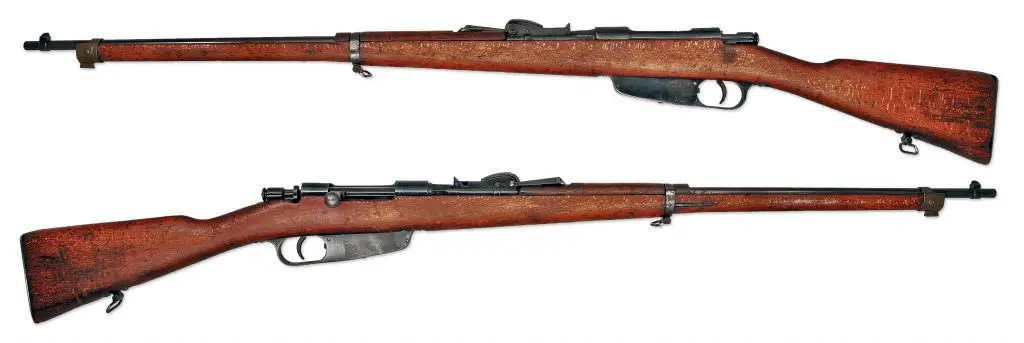
Original M1891 Rifle (with gain twist!) served well in WWI, and derivatives in WWII. Image from C&Rsenal’s great Carcano 91 page. It was sufficiently accurate that the Italians just issued designated marksmen select iron-sighted Carcanos — any scoped “sniper” is a postwar fake, as is any full-length rifle with a turned-down bolt.
One reason for the persistence of dislike of Japanese weapons is their relatively crude finish compared to the beautiful rust-blue of their European counterparts. But this resulted from the fact that Japan at war’s outbreak was as resource-limited as Germany was during the production of “last ditch” weapons, as Shermans and T-34s did celebratory pivot turns on former arms plants. The resource limitation drove the Japanese to innovate, for example going to chrome linings (for strength, not just corrosion resistance) and phosphate finishes (for speed of production, not just corrosion resistance) before most of the world.
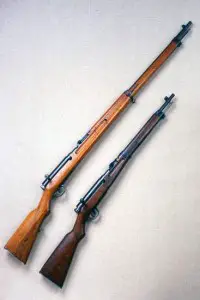
Type 38 (1905) rifle and carbine, 6.5mm. Standard Japanese weapons through early WWII. Not sure where we cribbed this image from — if you know let us know so we can give credit.
Both the “weak” Arisaka and Carcano actions were modern, the Arisaka being a clear Mauser derivative and the Carcano, while a design all its own, offered such modern features as forward dual locking lugs. When introduced (1891), it was arguably the most modern rifle in the world, and like its contemporary the Mosin-Nagant it, and its 6.5 mm cartridge, was still in service at war’s end. (Which came a little earlier for Italy than for the USSR).
Italian and Japanese machine gun designs were different, but that’s not saying that they were practically or tactically inferior. The high rate of fire of the Japanese LMGs is cited in almost every American memoir of Pacific combat. The Japanese could sustain this high rate, especially with the top-mounted magazine of the Type 99. (Guns of this design are much faster to reload, by an a/gunner, than a bottom-loading gun like the BAR is by its single-man crew).
Another reason to disparage these weapons? These nations lost. (Probably not a major reason, given the fanboys of all-things-German loose in the world today. We’re reliably informed that the Third Reich fell short of the planned 1,000 years). In the case of the Italians, there’s also an impression that they lost in part because they weren’t trying terribly hard (probably true for some individuals and not for others). Collectors might want the weapons of losers, just not quitters.
Yet another, and possibly the major, underlying reason for the belief, of course, is the residue of war-era (and “Yellow Peril”-era) racism against the Japanese, and northern European ethnocentrism against Southern Europeans in general, and Italians in particular, from the later waves of United States immigration. These expressions are less open now, but in 1976 you had no difficulty hearing negative impressions of Japanese and Italian firearms by countertop commandos, impressions that were invariably followed up by negative stereotypes (Japanese all had bad vision and made lousy shots; Italians wanted to make love, not war).
Let’s assume arguendo that there are two human phenotypes, call one “martial ardor” or “readiness to fight,” and one “strategic/conceptual ability” or “combat-oriented leadership,” that represent the scrappiness and cunning of a combatant. Let’s further assume that these phenotypes are to some degree heritable, and that there are distinct median levels in these traits in distinct groups. Let us make a fourth assumption, that the medians of these traits might be lower among the Japanese and Italian populations than among, say, Germans.
As the history of the war tells us, these two nations produced men and units that were the equal in “scrappiness” and “cunning” of any force in the world. Consider the thorough Japanese defeat of the ABDA allies in the first six months of the Pacific War, or the Italian naval special operations of the Decimo MAS, or for that matter their forerunners in the war with Austria-Hungary, the first proto-frogmen to sink a battleship.
If you still think that these two great nations produced junk guns, try to get some trigger time on any of the Japanese LMGs, especially the Type 99; or on a Beretta M38 SMG or its derivatives (which is what the MP40 wants to be when it grows up).
And don’t let yourself believe that an enemy weapon is an inferior weapon because you think the enemy is — well, choose your favorite put-down. Because whatever your enemy is, the guys who designed his weapons probably are not.
How Many Rifles, and Where Are They?
Nick Jenzen-Jones has a new and interesting working paper at the Small Arms Survey in Geneva (Here’s the Abstract and the PDF). The title of the paper is dry but promising: Global Development and Production of Self-loading Service Rifles 1896 to the Present.
As always with the Small Arms Survey, this is a publication more aimed at non-proliferation NGOs and quangos than at enthusiasts, but that does not make Nick’s painstaking work any less interesting or useful to us.
Painstaking? It is. He goes deep into the history of semi-automatic and select-fire rifle production over a century and a quarter, and makes a valiant effort to make sense of conflicting numbers that come more from estimates, propaganda, wild guesses, and serial-number sleuthing than they do from any real solid reporting.
Here is a discussion of AK production, probably the toughest nut to crack for those who want to know, “How many?”
AK-type rifles are the most common self-loading service rifle in the world today by a considerable margin, and are thought to constitute in excess of 40 per cent of the total number of self-loading rifles produced up to the present day. Their ubiquity means that they are encountered in almost every modern conflict zone. Nearly 200 variants, copies, and derivatives of the AK rifle have been identified to date.
According to Russian sources, IZHMASH (now Kalashnikov Concern) only patented the weapon’s design in 1997, and in 2006 Russian Federation AK-type rifles accounted for only 10 per cent of the world’s production of this type
The Soviet-era practice was to share their design and engineering widely to encourage production in nearby “fraternal socialist” allies, and to promote industrial development in distant allies. Nations as diverse as India, Iraq, North Korea and Egypt would never have produced AK clones without direct Soviet assistance (the Egyptian plant was even supervised by Soviet engineers, initially, and used every single process of its Soviet prototype).
So the modern Russian inability to issue a concrete figure of X AKs produced is an understandable result of previous policies, as well as of Izmash and Amtorg/Rosoboronexport giving up control of the design of the firearm. The AK’s very simplicity led to further proliferation of manufacture, especially after the 1960s change from machined receiver to stamped with machined and stamped parts riveted in place.
But the paper goes far beyond AKs to discuss the entire history of the self-loading rifle.
Here’s a snip of Table 1 from the paper, which should give you an idea just how thorough and historically interesting it is:
Sure, it’s missing some firearms that were produced in the millions, including the M1/2/3 Carbine (~5.5 million in WWII alone, if memory serves), the G/K 43 (perhaps under a million), and the AG 42 and Hakim. But all of those are obsolete firearms washed away by the tide of ARs, and, especially, AK. And some of them, like the M1 Carbines, are mentioned elsewhere in the report. Sure, you can quibble with the numbers. But the original table includes extensive sourcing and notes. He appears to be, from his notes, excluding firearms produced for civilian markets including non-militarized law enforcement, which means he’s not capturing the bulk of AR production.
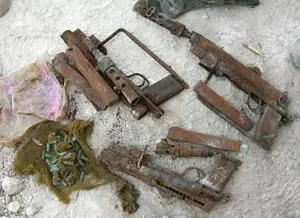
Cached weapons, like these Port Said 9mm SMGs (a license-built Carl Gustav M45B ‘Swedish K’) recovered after decades underground, can last a very long time.
Production, of course, is only half of the conundrum, and Nick tries to understand and estimate inventory shrinkage and diversion, demilitarization and destruction, and wear-out. The problem with that, of course, is not only that there are no comprehensive prior numbers to be exploited as found data, but also that rifles are fiendishly durable goods; and are valuable enough that many possessors will take care to maintain and store them properly, if they can and know how. He makes this note:
International Security Assistance Force (ISAF) troops in Afghanistan captured several well-worn but functional examples of AK and AKM rifles manufactured in the 1950s (Iannamico, 2015).
In fact, in Afghanistan in 2002, our team captured, along with tons of common AKMs and a mountain of World War II weapons, a quantity of prewar Mauser rifles and ZB-26 machine guns, and very first model AK-47s that were 1940s production with a primarily stamped receiver, that pre-date the familiar machined AK-47 receiver. Along with them, we turned up some real oddities like a Ross. All were functional, although there was no ammunition for the .303 and 7.92mm weapons in the caches.
One can quibble with this aspect or that of what Nick has written is, but the fact is that this is the single most comprehensive look at world service rifle stockpiles. Were the numbers to be graphed, they’d need to have really large confidence-interval indications, like error bars or something, because the data are squirrelly, but that’s not his fault. Indeed, to produce a readable, informative document out of such a primordial chaos of data is a signal achievement. We predict that this paper will be widely cited in future scholarship.
President’s Day Sale on Precision Guided Rifles
Received from Tracking Point, and we thought we’d pass it on to all of you. The biggest single objection people have had to a Tracking Point Precision Guided Firearm has been cost — and that’s not going away; it’s the price of being an early adopter of future technology in any milieu. (People are still amazed to hear what a Mac IIcx cost us in 1987). Still, the cost has come down to much closer to the cost of a premium AR and a premium scope at these discounted prices… price-wise, they don’t bear comparison to a bottom-tier AR at $500 or less, but then, they offer a completely different capability you can’t just pluck off any LGS shelf.
Presidents Day Pricing on .300BLK, 5.56 and 7.62… Limited Time Only!
Call to Order: 512.354.2114
M400 XHDR
- .300 BlackOut
- 400-Yard Lock Range
- 2-14x Zoom
- 10 MPH Target Velocity
- * Combat Tan + $495
- * 50% off Ext. Warranty
- Learn More Now
M600 SR
- 5.56MM NATO
- 600-Yard Lock Range
- 2-14x Zoom
- 15 MPH Target Velocity
- * Combat Tan + $495
- * 50% off Ext. Warranty
- Learn More Now
M800 DMR
-
- 7.62MM NATO
- 800-Yard Lock Range
- 3-21x Zoom
- 20 MPH Target Velocity
- * Combat Tan + $495
- * 50% off Ext. Warranty
- Learn More Now
Remember! Limited time offer – Call Today!<
Line busy or want a call back at a later date? Click Here
That’s TrackingPoint’s pitch, and as we said, we’re passing it on.
Obviously we’re fans of the technology and the company, so you might ask, why don’t we own one of these things? What, are we hypocrites?
We don’t think so, we have reasons for not buying, yet. First, it is a lot of money for a firearm. Second, you have to have a reason to shoot it to justify spending that money. (It also works best with Tracking Point;s own ammo, which is, to put it mildly, premium priced). Third, you have to have a place to shoot it.
If we were javelina assassins working the ranches and fields of Texas we would be all over this offer like ugly on a Womyn’s Studies convention. But as it is, we have a selection of 100-yard ranges to shoot at, and hunting around here tends to be a close-in sport, with a long shot being 200 yards, and most shots with a firearm taking place at a range where archery would do the job. However, there is a 1000-yard range complex fighting its way through zoning less than two hours away, in the southwestern corner of NH.
Let’s See Whitworths Shoot!
Last month we had a couple posts on the Sharpshooters of the Civil War, and on the Confederates’ unique Whitworth rifle.
Fred Ray, who’s written an excellent book on the Rebel Sharpshooters, sold us a copy of his book (highly recommended, and it’ll be in the next review roundup), and also linked us to a few videos of modern Whitworth shooters. Fred has forgotten more about this stuff than we’ve ever learned, so you can read what he writes with confidence.
Let’s take them in the inverse order from the way Fred posted them: hardest first. Here is a guy trying to hit a target at 1,300 yards with a Whitworth.
That kind of hit was credibly reported by both Rebel and Yankee observers of the Confederate marksmen. (The English Whitworth rifle was only used by the Confederates).
One of the real problems is seeing the target. While many of the wartime Whitworths were equipped with high-tech (for 1860!) Davidson telescopic sights…  …this marksman is shooting over irons. One of the real problems at that range is seeing the target. Since more of you are familiar with more modern rifles, consider that the front sight post of an M16A1 rifle subtends just enough arc to match an E-type silhouette at 175 meters.
…this marksman is shooting over irons. One of the real problems at that range is seeing the target. Since more of you are familiar with more modern rifles, consider that the front sight post of an M16A1 rifle subtends just enough arc to match an E-type silhouette at 175 meters.
Another fact that should be evident is the sheer power of the Whitworth. Look at that thing kick! The recoil is visibly greater than that of an ordinary rifle-musket.
Reproduction Whitworths
The class of the repro field is the long-discontinued Parker-Hale, but they are few and far between. After Parker-Hale went the way of all flesh, there was a EurArms repro which used the Parker-Hale barrels with its own lock and stock. Here, Balázs Németh, the proprietor of CapAndBall.eu has gotten his hands on one of them, and not only fires it, but provides a good run down on its unique and remarkable technology. “The Whitworth,” he notes, “pushed the limits of aimed fire out to 1½ miles.”
Pedersoli is making a new version of the Whitworth. It is available in Europe, but not exported to North America (yet, we hope). Here is his video rundown on the Pedersoli Whitworth. The Pedersoli has hexagonal rifling, but it’s cold hammer-forged. The rifle also has much simpler sights. He did not have a hex bullet mold, so used a .451″ cylindrical round, and still got quite good accuracy at 50 and 100 meters.
The finish on the Pedersoli rifle is, like many of their premium muzzle-loaders, very good.
His enthusiasm for these rifles, so far ahead of their peers that they seemed ahead of their time, is infectious.
Finally, here’s a special treat. It’s our friend from Cap and Ball again, but here he’s firing an original Civil War vintage American target rifle, of the sort that many sharpshooters mustered in with.
If you go to the Fred Ray post that we linked way, way up there, you’ll also see another one about the Civil War buck-and-ball cartridge — the only loading we’re aware of that has its own statue at Gettysburg. But that’s another story!
Monster Firearms Auction Thurs-Sunday at Rock Island
 Rock Island Auctions is holding their largest-ever auction this weekend (although the action starts Thursday). Over 10,000 firearms are included in many thousands of lots (some lots include up to six arms) in this Regional auction, and there’s something there for everyone. Unlike a Premier auction, which has predominantly high and very-high-end collectibles, this auction has pieces for the beginner as well as the advanced collector, and some guns for the practical shooter or gun retailer.
Rock Island Auctions is holding their largest-ever auction this weekend (although the action starts Thursday). Over 10,000 firearms are included in many thousands of lots (some lots include up to six arms) in this Regional auction, and there’s something there for everyone. Unlike a Premier auction, which has predominantly high and very-high-end collectibles, this auction has pieces for the beginner as well as the advanced collector, and some guns for the practical shooter or gun retailer.
Ian at ForgottenWeapons.com often does videos on some of the exotica for sale at these auctions.
The Rock Island auction catalog is here online. It’s not at all hard to set up an account and bid online, but make sure you understand the payment terms, particularly the nasty little auctioneers’ convention, the Buyers’ Premium.
The Rock Island blog promotes some of the more interesting pieces. This report on a particular Japanese Type 99, tied to the Battle of Saipan by a plaque on the right side of its butt, is a tour de force. Despite the non-guarantee-able provenance of the gun, the plaque does align (as the long post proves) perfectly with the history of the invasion, and the author tracks it to a probable capture by some member of the New York Army National Guard 27th Division.
The Rifle – Japanese Type 99
By now, you may be wondering how this Japanese Type 99 is tied to the Battle of Saipan. Attached to the right side of the butt is a small brass plaque that reads,
“At 0440 on the morning of 16 June 1944, an American infantryman just landing on the shores of Charan-Kanoa Beach, Saipan, threw a hand grenade at a Japanese sniper killing him instantly. The forward stock of the rifle was damaged by the explosion. Presented by Commander Walter Bantau. USNR.”
Besides giving us a really cool story, and perhaps the ultimate tangible connection to it, the plaque also provides some very helpful information that pinpoints its place in history – where it was and what it was doing.
Of course, the dates and location are provided on the plaque, but what other clues can we obtain? For starters, based on the landing time we know that the man who threw the grenade must have been on of the soldiers of the 27th Infantry Division of the National Guard that arrived long before dawn broke on D+2, June 17. The plaque does indicate a landing on June 16, and many sources are conflicted on this information. In the research for this article, it was found that at 0330 on June 16, Marines were busy holding off a desperate second Japanese counterattack attempting to retake the beach and “push the Americans into the sea.”
We also know that in the 27th, there were only three infantry regiments: the 105th (formerly the 2nd New York), the 106th, and the 165th (formerly the 69th, a.k.a. “The Fighting 69th” and “The Fighting Irish”), so the fortunate grenadier must have been in one of those regimentss. Each of those regiments is comprised of men from the New York Army National Guard so we can say with some certainty that it was likely a New Yorker who killed the sniper on the beach that day.
The Type 99 not only has that interesting plaque (and the potted history of the Saipan campaign that Rock Island has assembled for its next owner), but it is also one of the finest examples of a bringback Type 99 we’ve seen in a long time. It’s not the usual ground-mum beater!
Good luck and happy bidding. It’s a safe bet that you’ll be bidding against us if you’re bidding on anything both rare and Czech or Czechoslovak.
Homebuilt Innovation: Ultra Light .22 Bolt Repeate
This is a remarkable home made survival-type .22 rifle that is chock full of ingenuity.
It may be amateur made, but its builder, who posts on YouTube as ECCO Machine, has professional equipment, and, more importantly, skills. Most parts of the rifle are machined from billets of aluminum, titanium, and ABS plastic. The barrel is a carbon-fiber-wrapped .22 barrel liner. The bolt is made of machined titanium alloy with a welded-on handle, and it has a rare feature in a rimfire rifle, forward locking lugs.
The resulting rifle is ultralight: less that 1 lb. 3 oz. The featherweight rifle stows itself into a package less than a foot and a half long.
Unlike most amateur’s adherence to the material or materials, and process or processes that they know best, ECCO Machine’s practical use of a range of materials and methods is something worthy of a major manufacturer. Plastic, carbon fiber, aluminum, and titanium are all used in places where they’re most suitable.
The only steel or stainless-steel parts are the sear, striker, spring, screws, the barrel liner only, and a modified Savage stainless mag (with a really clever and dead-simple retaining catch that is its own spring).
The bolt’s forward locking lugs lock into a barrel extension, as in an AR; the barrel extension is also made of titanium. The rifle is readily taken down without tools. Everywhere the solutions chosen show both imagination and a practical turn of mind. For one thing, he came up with a really clever way to manage the cartridge feed by making the ejector do double duty.
There’s a really neat surprise in the grip (which he doesn’t count against the gun’s 18.9 oz weight) and the carbon-fiber stock can hold up to 40 .22 long rifle cartridges. There is a nifty titanium front sight base modeled on the classic AR FSB, and a special threaded muzzle cap that’s part of the rifle folding/stowage mechanism. (An alternate threaded adapter can convert these fine threads to the threads needed to attach a suppressor).
One of these should be built into ever ejection seat on every combat jet. Heck, we should build one into the RV-12.
There are several other interesting amateur builds on ECCO Machine’s YouTube channel. Hat tip, Hrachya at TFB.
Can You Help These Guns Find a Forever Home?
And can you have too many guns? Brownells says yes, you can. Well, they can, being a dealer… and they’ve got a clearance running on firearms. (Sorry, overseas readers. Your bad fortune today).
Follow this link to go there: Brownells Firearms Overstock Sale.
All the guns in question are new overstock. The pipeline is jammed with ARs in particular, that were produced in anticipation of an Omigawd-Hillary!-Won run on gun dealers nationwide. That backed-up inventory (and the costs of storage and carrying, especially with manufacturers, jobbers, and dealers who are leveraged and making payments on this inventory) is putting a hell of a downward price pressure on the AR market. For the premium brands, it’s showing up as a sales slowdown or a change from backlog to inventory. For the bargain brands? It’s race to the bottom, pricewise.
What you’ll find are 20 models of overstock firearms, including:
- Quite a few ARs from many vendors’;
- Some under $500, an unheard-of price a couple of years ago;
- One AK;
- Quite a few inexpensive handguns, including S&W (which has a good reputation) and Taurus (which only has a reputation);
- A few expensive handguns, including an H&K VP9, for those who seek a BDSM relationship with their pistol manufacturer.
All at good prices.
It is a very good idea to line up your transfer dealer first. A lot of dealers get very cheesed off when you use them to transfer a gun you bought on a deal like this (or from a cutthroat discounter like Bud’s or KY) and you bought it at a price that they can’t get wholesale. Some dealers don’t mind, and actually pursue transfer business. You want to be doing your transfers with the second guy.
If you’re a dealer, and you’re the first guy, our advice is don’t badmouth Bud’s or KY (or a clearance at Brownells). Just treat the customer right, price transfers reasonably and do ’em quickly enough that you’re not losing on him, and try to take the opportunity to (1) sell accessories, which have a way better margin, and (2) build a relationship with the customer.
Sure, some customers are bottom feeders who will put themselves through anything to save $5 and think customer loyalty is for chumps. But for every one of those, and every one of the guys who wants to spread his business around all the local shops, there’s a whole bunch of people who like to settle in with one gun dealer. In almost every business, your best business is repeat business, and your next best is referral business. That’s 100% certain-sure true for gunshops.

Kevin was a former Special Forces weapons man (MOS 18B, before the 18 series, 11B with Skill Qualification Indicator of S). His focus was on weapons: their history, effects and employment. He started WeaponsMan.com in 2011 and operated it until he passed away in 2017. His work is being preserved here at the request of his family.

